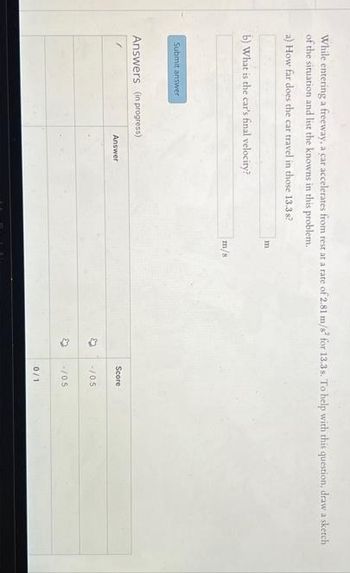
College Physics
11th Edition
ISBN: 9781305952300
Author: Raymond A. Serway, Chris Vuille
Publisher: Cengage Learning
expand_more
expand_more
format_list_bulleted
Concept explainers
Topic Video
Question

Transcribed Image Text:While entering a freeway, a car accelerates from rest at a rate of 2.81 m/s² for 13.3s. To help with this question, draw a sketch
of the situation and list the knowns in this problem.
a) How far does the car travel in those 13.3s?
b) What is the car's final velocity?
Submit answer
Answers (in progress)
Answer
m
m/s
(3
4
Score
-/0.5
-/0.5
0/1
Expert Solution
This question has been solved!
Explore an expertly crafted, step-by-step solution for a thorough understanding of key concepts.
Step by stepSolved in 3 steps with 3 images

Knowledge Booster
Learn more about
Need a deep-dive on the concept behind this application? Look no further. Learn more about this topic, physics and related others by exploring similar questions and additional content below.Similar questions
- In 1967, New Zealander Burt Munro set the world record for an Indian motorcycle, on the Bonneville Salt Flats in Utah, with a maximum speed of 183.58 mi/h. The one‐way course was 5.00 mi long. Acceleration rates are often described by the time it takes to reach 60.0 mi/h from rest. If this time was 4.00 s, and Burt accelerated at this rate until he reached his maximum speed, a. how long did it take Burt to complete the course? b. Sketch position vs time, velocity vs. time, and acceleration vs. time graphs for the race.arrow_forwardA high-performance sports car can go from 0 to 100 mph (44.7 m/s) in 7.9s. a) What is the car's average acceleration? b) The same car can come to a complete stop from 30 m/s in about 3.2 s. What is its average acceleration?arrow_forwardA) Compute the position of the sandbag at a time 1.25 s after its release. Express your answer in meters. B) Compute the magnitude of the velocity of the sandbag at a time 1.25 s after its release. Express your answer in meters per second.arrow_forward
- A car starts from rest, then accelerates at 1.20 m/s? for 7.00 s. It hits the brakes, slowing to a stop at a rate of -4.25 m/s². What is the total time for the problem? (Unit = s)arrow_forwardA student drives 40 km south in an attempt to get to a science fair competition before realizing he missed the exit. He turns around and drives back north 15 km before arriving. The total time of travel was 0.75 hr. What is his speed? What is his velocity?arrow_forwardThe height of a helicopter above the ground is given by h = 3t^2+2.0t^4, where h is in meters and t is in seconds. At t=2.0s, the helicopter releases a small bag. a) Calculate the maximum height the bag reaches measured from the ground. b) How long after the bad is released, does it strike the ground? c) Calculate the speed of vag when it hits the ground.arrow_forward
- A certain freely falling object, released from rest, requires 1.25 s to travel the last 25.0 m before it hits the ground. (a) Find the velocity of the object when it is 25.0 m above the ground. (Indicate the direction with the sign of your answer. Let the positive direction be upward.) m/s (b) Find the total distance the object travels during the fall. marrow_forwardPart (a) What is its velocity after 23 seconds? Give your answer in m/s. Numeric : A numeric value is expected and not an expression. V = Part (b) How far has it gone in meters? Numeric : A numeric value is expected and not an expression. X =arrow_forwardpls help solve this problemarrow_forward
- You throw an object up with an initial velocity of voy=13 m/s from a height of y=25 m. Part a) How long, in seconds, does it take for the object to reach the ground? Part b) What is the object's final velocity, in meters per second, as it impacts the ground? Part c) Find the time, in seconds, if you instead threw the object down with the same velocity, voy?arrow_forwardPls help ASAParrow_forwardA certain freely falling object, released from rest, requires 1.95 s to travel the last 32.0 m before it hits the ground. (a) Find the velocity of the object when it is 32.0 m above the ground. (Indicate the direction with the sign of your answer. Let the positive direction be upward.) m/s (b) Find the total distance the object travels during the fall. marrow_forward
arrow_back_ios
SEE MORE QUESTIONS
arrow_forward_ios
Recommended textbooks for you
 College PhysicsPhysicsISBN:9781305952300Author:Raymond A. Serway, Chris VuillePublisher:Cengage Learning
College PhysicsPhysicsISBN:9781305952300Author:Raymond A. Serway, Chris VuillePublisher:Cengage Learning University Physics (14th Edition)PhysicsISBN:9780133969290Author:Hugh D. Young, Roger A. FreedmanPublisher:PEARSON
University Physics (14th Edition)PhysicsISBN:9780133969290Author:Hugh D. Young, Roger A. FreedmanPublisher:PEARSON Introduction To Quantum MechanicsPhysicsISBN:9781107189638Author:Griffiths, David J., Schroeter, Darrell F.Publisher:Cambridge University Press
Introduction To Quantum MechanicsPhysicsISBN:9781107189638Author:Griffiths, David J., Schroeter, Darrell F.Publisher:Cambridge University Press Physics for Scientists and EngineersPhysicsISBN:9781337553278Author:Raymond A. Serway, John W. JewettPublisher:Cengage Learning
Physics for Scientists and EngineersPhysicsISBN:9781337553278Author:Raymond A. Serway, John W. JewettPublisher:Cengage Learning Lecture- Tutorials for Introductory AstronomyPhysicsISBN:9780321820464Author:Edward E. Prather, Tim P. Slater, Jeff P. Adams, Gina BrissendenPublisher:Addison-Wesley
Lecture- Tutorials for Introductory AstronomyPhysicsISBN:9780321820464Author:Edward E. Prather, Tim P. Slater, Jeff P. Adams, Gina BrissendenPublisher:Addison-Wesley College Physics: A Strategic Approach (4th Editio...PhysicsISBN:9780134609034Author:Randall D. Knight (Professor Emeritus), Brian Jones, Stuart FieldPublisher:PEARSON
College Physics: A Strategic Approach (4th Editio...PhysicsISBN:9780134609034Author:Randall D. Knight (Professor Emeritus), Brian Jones, Stuart FieldPublisher:PEARSON

College Physics
Physics
ISBN:9781305952300
Author:Raymond A. Serway, Chris Vuille
Publisher:Cengage Learning

University Physics (14th Edition)
Physics
ISBN:9780133969290
Author:Hugh D. Young, Roger A. Freedman
Publisher:PEARSON

Introduction To Quantum Mechanics
Physics
ISBN:9781107189638
Author:Griffiths, David J., Schroeter, Darrell F.
Publisher:Cambridge University Press

Physics for Scientists and Engineers
Physics
ISBN:9781337553278
Author:Raymond A. Serway, John W. Jewett
Publisher:Cengage Learning

Lecture- Tutorials for Introductory Astronomy
Physics
ISBN:9780321820464
Author:Edward E. Prather, Tim P. Slater, Jeff P. Adams, Gina Brissenden
Publisher:Addison-Wesley

College Physics: A Strategic Approach (4th Editio...
Physics
ISBN:9780134609034
Author:Randall D. Knight (Professor Emeritus), Brian Jones, Stuart Field
Publisher:PEARSON